Trends in Sustainable Development Reports
 Trends in Sustainable Development – Small Island Developing States
Trends in Sustainable Development – Small Island Developing States
:: 2010-2011
Issued in support of the five-year review of the Mauritius Strategy of Implementation for the sustainable development of SIDS, the report highlights the vulnerabilities of SIDS and recent trends in their sustainable development.
The key areas covered by the report are:
- climate change
- disaster management
- trade and finance
- tourism
- energy
- natural resources
- social development
It also provides a visual summary of progress made by SIDS in attaining the Millennium Development Goals (MDGs), based on analysis performed by UNDP and ESCAP.
A Snapshot of Trends:
Climate Change
- The combined annual carbon dioxide output of SIDS accounts for less than 1% of global emissions. However, like other countries, SIDS face serious challenges in reducing emissions and moving to clean energy. From 1990 to 2006, carbon dioxide emissions of SIDS increased at an average annual rate of 2.3%.
- Areas of greatest concern for SIDS in terms of climate change adaptation are water resources, agriculture and food security, and the protection of coastal zones.
Disaster Management
- Samoa, Saint Lucia, Grenada, Vanuatu, Tonga and Maldives lead the list of 180 countries with the highest economic losses on capital stock in relative terms due to natural disasters from 1970 to 2006. In the case of Samoa, due to the relatively small size of its economy, the damages from a tropical storm and a forest fire in 1983 as well as three tropical storms in a row from 1989 to 1990, may have set its capital stock back more than 35 years.
Trade and Finance
- In recent years, many SIDS have experienced a rapid rise in their debt burden which, coupled with rising logistics costs and decreasing workers’ remittances, has exacerbated the negative impact that the financial crisis has had on their economies.
- Logistics performance is significantly worse in SIDS than in other countries at similar levels of development, based on the ranking of the World Bank’s 2010 Logistics Performance Index (LPI), which includes transport costs, quality of infrastructure (e.g., roads, ports, etc), tracking and tracing of consignments, and timeliness of delivery.
- The lack of reliable external capital flows has negatively impacted external debt levels, which have exceeded sustainability standards in many SIDS. During the past ten years, there has been no clear trend toward reducing external debt levels. On the contrary, in 2008, 12 out of 21 SIDS for which data was available showed external debt stocks that exceeded 50% of their Gross National Income (GNI).
Tourism
- On average, international tourism receipts accounted for 51% of the total value of exports of SIDS in 2007, up from 42% in 2000. This compares to less than 10% in other developing countries. In 2007, the share of international tourism receipts was larger than 50% of exports in twelve SIDS.
Energy
- The vulnerability of SIDS in terms of energy resources is mostly characterized by their dependence on imported oil and other fossil fuels for electricity generation and transport. On average, more than 90% of energy is sourced from oil imports, which account for the largest claim on foreign exchange earnings in SIDS.
Natural Resources
- Overall fishery production levels are increasing in SIDS. However, illegal, unreported and unregulated fishing, harmful fishing methods, and overfishing are severely damaging fish stocks in many SIDS, which are already threatened by climate change, the loss of coral reefs, and ocean warming and acidification.
Social Development
- SIDS have made considerable progress toward the attainment of certain social development goals, including health, education, gender balance, and access to water and sanitation. However, systematic eradication of poverty has remained a challenge for most countries. Limited human resource capacity is an ongoing issue, particularly due to the high levels of emigration among the most educated population.
Download Full Report
Trends Reports
- 2010-11 Trends SIDS
- 2010-11 Trends SCP
- 2010-11 Trends
- 2008-09 Trends Africa
- 2008-09 Trends
- 2006-07 Trends

